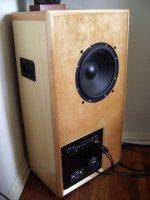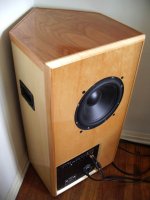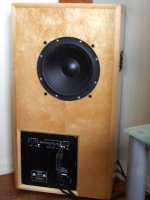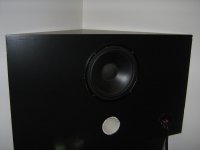Here's a question:
I have a 4'X8'X3/4" sheet of 20 year old particleboard sitting in my garage taking up space. I have no plans for it. I'm also planning to build two large sealed subwoofer cabinets. So the question is (are): Is it worth the expense of buying MDF or birch plywood when I have particleboard for free? If so, is this particleboard good for anything other than floor underlayment, cheap furniture, or firewood? Is there a way to make the particleboard "work" for a sub, such as extra bracing or glueing something like HDF/masonite to it? Does anyone in the Kansas City/Lawrence area want a free 4X8X3/4 sheet of particleboard? I'll help load it in your truck!
I have a 4'X8'X3/4" sheet of 20 year old particleboard sitting in my garage taking up space. I have no plans for it. I'm also planning to build two large sealed subwoofer cabinets. So the question is (are): Is it worth the expense of buying MDF or birch plywood when I have particleboard for free? If so, is this particleboard good for anything other than floor underlayment, cheap furniture, or firewood? Is there a way to make the particleboard "work" for a sub, such as extra bracing or glueing something like HDF/masonite to it? Does anyone in the Kansas City/Lawrence area want a free 4X8X3/4 sheet of particleboard? I'll help load it in your truck!
chipboard will work and has certainly been used before. the more furniture grade lower density stuff may not be perfect, but in reality wont be a million miles away from MDF or ply, except maybe BB ply.
Enough bracing and itll be fine, its just the ugly edges butt joints create which would annoy me, the material itself will do the job.
Enough bracing and itll be fine, its just the ugly edges butt joints create which would annoy me, the material itself will do the job.
I think any PB, after sitting in a garage for 20 years, is probably compromised by moisture and/or heat. If you still want to use it, make the subs out of a combination of new material laminated over the old stuff. No need to use anything exotic; a layer of good ply would probably suffice.
I am beginning to think that many "problems" associated with material choice are effectively overcome by using two layers of different materials. Neither has to be perfect by itself (if there is such a thing), so there are many possible combinations.
Pics of my 12" sealed sub, which includes panels made of PB and panels made of MDF, all covered with ply. The plate amp is in its own enclosure, isolated from the driver's space. The black things on the sides are the kind of handles used on road gear, and they're a great feature on a box this big. This 6 cu ft enclosure weighs well over 100 pounds, probably over 150.
Note that the back is not a flat panel. I think that might be the single most important factor in determining good acoustic properties of any enclosure. Again, I cannot cite a study or provide hard data, but I'd be willing to learn from anyone who can. I don't mean that speakers with flat backs can't sound good, but all the speakers I've built with a non-flat back seem to sound better. Even with lots of absorbent material, I imagine those soundwaves just banging off a flat panel, straight back through the cone.
Peace,
Tom E
I am beginning to think that many "problems" associated with material choice are effectively overcome by using two layers of different materials. Neither has to be perfect by itself (if there is such a thing), so there are many possible combinations.
Pics of my 12" sealed sub, which includes panels made of PB and panels made of MDF, all covered with ply. The plate amp is in its own enclosure, isolated from the driver's space. The black things on the sides are the kind of handles used on road gear, and they're a great feature on a box this big. This 6 cu ft enclosure weighs well over 100 pounds, probably over 150.
Note that the back is not a flat panel. I think that might be the single most important factor in determining good acoustic properties of any enclosure. Again, I cannot cite a study or provide hard data, but I'd be willing to learn from anyone who can. I don't mean that speakers with flat backs can't sound good, but all the speakers I've built with a non-flat back seem to sound better. Even with lots of absorbent material, I imagine those soundwaves just banging off a flat panel, straight back through the cone.
Peace,
Tom E
Attachments
haha yeah
hahah i missed the '20 year old' bit! perhaps 20 year old chipboard, (or MDF or ply of any kind) will probably have deteriorated in that time.
@madisonears: I agree, ive built a pair of boxes with 12mm MDF joined with aluminium right angle and epoxy glue, lined with plasterboard lath, which was glued on with rubber solution/evostik/silicone(memory...). Very good results from what was a modestly built box. non parallel walls make a huge difference on the rear panel, id love to do the same but i lack a garage and table saw....If i was to then id try the 'inverse' corner/less volume friendly approach, since a 90° angle on the rear will still bounce MOST of the sound back thru the cone, albeit after 2 reflections perhaps instead of one. The reflection damping is just as important i think IMHO.
hahah i missed the '20 year old' bit! perhaps 20 year old chipboard, (or MDF or ply of any kind) will probably have deteriorated in that time.
@madisonears: I agree, ive built a pair of boxes with 12mm MDF joined with aluminium right angle and epoxy glue, lined with plasterboard lath, which was glued on with rubber solution/evostik/silicone(memory...). Very good results from what was a modestly built box. non parallel walls make a huge difference on the rear panel, id love to do the same but i lack a garage and table saw....If i was to then id try the 'inverse' corner/less volume friendly approach, since a 90° angle on the rear will still bounce MOST of the sound back thru the cone, albeit after 2 reflections perhaps instead of one. The reflection damping is just as important i think IMHO.
I like the way you maximized the footprint by making it fit neatly in the corner. An the driver is offset slightly. and the handles and easy-access plateamp. That's a well thought-out design. I suspect I'll laminate like you did, or use the particleboard for internal bracing. Thanks for the advice.
The Matrix
Sorry to be late to the discussion.
Here is a link to my favorite solution to many box building problems.
Bowers & Wilkins - Matrix
I have used variations of this concept in numerous builds.
The bass cab for my version of the Sunflowers.
Sealed box for the Hi-Vi SP-10 driver. A monster with 68# magnet.
Sorry to be late to the discussion.
Here is a link to my favorite solution to many box building problems.
Bowers & Wilkins - Matrix
I have used variations of this concept in numerous builds.
The bass cab for my version of the Sunflowers.
An externally hosted image should be here but it was not working when we last tested it.
Sealed box for the Hi-Vi SP-10 driver. A monster with 68# magnet.
An externally hosted image should be here but it was not working when we last tested it.
B & W Matrix
Hi there: From the B & W Matrix site, I noticed that this group uses foam absorbers to reduce standing waves between the planes of the matrix. How may DIY'ers use foam absorbers to cure a problem caused by the bracing frames
(or even identified the problem)? ...regards, Michael
Sorry to be late to the discussion.Here is a link to my favorite solution to many box building problems. ...Bowers & Wilkins - Matrix ]
Hi there: From the B & W Matrix site, I noticed that this group uses foam absorbers to reduce standing waves between the planes of the matrix. How may DIY'ers use foam absorbers to cure a problem caused by the bracing frames
(or even identified the problem)? ...regards, Michael
I am not totally clear on what you are referring to at B&W, but I use a poly-based product called "Acoustastuff" from Parts Express for internal damping. It comes in a semi-compressed 'giant cotton ball' and the user fluffs it up a bit (almost X-2) before placing in the cabinet. A couple dots of hot glue will hold it in place. Back in the day fiberglass insulation was a good choice but this product functions better and doesn't make you itch. Some builders use pillow stuffing from the local sewing supply center. Care must be taken not to block any vents if used in a bass reflex cabinet. In a sealed box it will increase the apparent internal volume as per the box design software used.
Thin foam rubber sheets or eggshell foam pads glued to at least one of each opposing surfaces are also used. Again PE has a good selection online. Some use indoor carpet or cork for the solution. Naturally, a cabinet with curved sides reduces the need for this element as there are fewer or no parallel internal walls to induce reflection.
Thin foam rubber sheets or eggshell foam pads glued to at least one of each opposing surfaces are also used. Again PE has a good selection online. Some use indoor carpet or cork for the solution. Naturally, a cabinet with curved sides reduces the need for this element as there are fewer or no parallel internal walls to induce reflection.
Last edited:
I think any PB, after sitting in a garage for 20 years, is probably compromised by moisture and/or heat. If you still want to use it, make the subs out of a combination of new material laminated over the old stuff. No need to use anything exotic; a layer of good ply would probably suffice.
I am beginning to think that many "problems" associated with material choice are effectively overcome by using two layers of different materials. Neither has to be perfect by itself (if there is such a thing), so there are many possible combinations.
Pics of my 12" sealed sub, which includes panels made of PB and panels made of MDF, all covered with ply. The plate amp is in its own enclosure, isolated from the driver's space. The black things on the sides are the kind of handles used on road gear, and they're a great feature on a box this big. This 6 cu ft enclosure weighs well over 100 pounds, probably over 150.
Note that the back is not a flat panel. I think that might be the single most important factor in determining good acoustic properties of any enclosure. Again, I cannot cite a study or provide hard data, but I'd be willing to learn from anyone who can. I don't mean that speakers with flat backs can't sound good, but all the speakers I've built with a non-flat back seem to sound better. Even with lots of absorbent material, I imagine those soundwaves just banging off a flat panel, straight back through the cone.
Peace,
Tom E
Those are almost made with the same idea that these ones are. I don't use them much anymore, but I still appreciate the design. (3/4 MDF for discussions sake)
Attachments
I could hear the cabinets when they were rigid, now I just hear the sound.The particle board is probably adding a colouration to the sound that you find pleasing. The stiff cabinet is not lively enough for your tastes perhaps.
I'll see if I can find the picture and post it later, but years ago someone built the ideal solution for eliminating enclosure problems. It was a sixteen foot long horn that started with a 12"x12" box to mount the driver and terminated at an 8ftx8ft opening built into the wall of the listening room. The walls of the horn were six to eight inch reenforced concrete. Of course two are required for stereo. So if you have the room in your back yard, a strong back and the uncontrollable need for perfection - Have at it. 
Last edited:
Characteristics Simplified
A little late to contribute but I found the following simplified but useful explanation at :
12.21 What is the best material to make speaker boxes out of? Why?
12.21 What is the best material to make speaker boxes out of? Why?
An ideal speaker cabinet material would be very stiff, so that
it would not tend to move with variations in box air pressure.
It would also be very well damped, so that if it ever does
deflect from air pressure, it will come back to the original
position without resonating. It would also have a very high
resonant frequency (supersonic), so that low frequency box air
pressure would not cause it to resonate. An attractive material
is preferred, and additional credit is given for a material
which is easy to cut, glue, and finish. A great material would
be cheap, too. Finally, it would be nice if the material were
light, because we all have to move our speakers sometimes,
and it's hard to appreciate good speakers with a sore back.
With all of those attributes, it would seem that no
material is perfect. However, there are many materials that
have enough of the above good attributes to make excellent
speaker cabinets. Yet each has advantages and disadvantages.
In the list of good speaker box materials below, letters are
used to indicate which attributes the material possesses.
S = Stiff
D = Damped
H = High Resonance
A = Attractive
M = Machinable
C = Cheap
L = Light
So how about Gator Board sandwiched between aircraft plywood?
Been thinking about what is actually the best material for a speaker enclosure.
I would think the most important attributes would be stiffness and damping.
A little late to contribute but I found the following simplified but useful explanation at :
12.21 What is the best material to make speaker boxes out of? Why?
12.21 What is the best material to make speaker boxes out of? Why?
An ideal speaker cabinet material would be very stiff, so that
it would not tend to move with variations in box air pressure.
It would also be very well damped, so that if it ever does
deflect from air pressure, it will come back to the original
position without resonating. It would also have a very high
resonant frequency (supersonic), so that low frequency box air
pressure would not cause it to resonate. An attractive material
is preferred, and additional credit is given for a material
which is easy to cut, glue, and finish. A great material would
be cheap, too. Finally, it would be nice if the material were
light, because we all have to move our speakers sometimes,
and it's hard to appreciate good speakers with a sore back.
With all of those attributes, it would seem that no
material is perfect. However, there are many materials that
have enough of the above good attributes to make excellent
speaker cabinets. Yet each has advantages and disadvantages.
In the list of good speaker box materials below, letters are
used to indicate which attributes the material possesses.
S = Stiff
D = Damped
H = High Resonance
A = Attractive
M = Machinable
C = Cheap
L = Light
So how about Gator Board sandwiched between aircraft plywood?
Just want to make a quick comment on "overbuilding". Keep in mind, in a bass reflex design the port and the air in it will most likely respond to pressure changes long before the walls of a cabinet start fluctuating. A simple wooden dowel anchored to the center of opposing sides divides the area of possible movement by at least 4. That alone raises the resonant frequency of each quarter panel to a point that a bass driver probably will not have a physical effect. The larger the box the more braces are needed, In my experience two evenly spaced dowels in a three foot tall cabinet is plenty. I always physically tie the horizontal and vertical.braces together where they intersect with a screw and a good amount of construction adhesive or epoxy..Adding at least one front to back intersecting brace ,also tied to the H and V braces gives superb results. If you are going to cover the cabinet, use a properly sized wood screw thru the side into the center of the dowel in addition to glue or epoxy between the end of the dowel and the inside of the box. If the cabinet has a final finish I try to make all the braces a hair over sized to apply a slight outward pressure to the walls
This method is great for ported cabinets and in my experience is even quite effective in a sealed box, if one doesn't want to mess with a matrix.
I like wooden dowels from .5 to .75" and even 1" because they are harder wood with little chance of vibrating if tied together.
I have never used anything thinner than .75" no mater the size of the speaker. I did a few with 1" MDF (weighs a ton) but .75' MDF is my standard now. On a couple subs I used .75" laminated to .5" show wood for top/bottom/sides/back. The front baffle was double MDf for rigidity and secure driver mounting.
This method is great for ported cabinets and in my experience is even quite effective in a sealed box, if one doesn't want to mess with a matrix.
I like wooden dowels from .5 to .75" and even 1" because they are harder wood with little chance of vibrating if tied together.
I have never used anything thinner than .75" no mater the size of the speaker. I did a few with 1" MDF (weighs a ton) but .75' MDF is my standard now. On a couple subs I used .75" laminated to .5" show wood for top/bottom/sides/back. The front baffle was double MDf for rigidity and secure driver mounting.
Last edited:
I'm saying Balsa wood, just because I can.. the stiffer something is the more it Rings.
Is there a list that describes all terminology somewhere? I'm trying to read the thread on tapped horns but there is so much terminology I don't have a clue what is being said.
Has anyone else seen Alucobond(tm)?
I friend of mine is using this material as external cladding for his new house.
For a thin section it is incredibly stiff, whilst being readily workable with "domestic" tools.
ALUCOBOND® - Alucobond Architectural
The above site has links to technical specifications and fabrication techniques.
cheers
Doug
I friend of mine is using this material as external cladding for his new house.
For a thin section it is incredibly stiff, whilst being readily workable with "domestic" tools.
ALUCOBOND® - Alucobond Architectural
The above site has links to technical specifications and fabrication techniques.
cheers
Doug
Manufacturers of speakers that "ring" quite a bit use piece of thin foam around woofer for damping at source. Look at those large towers manufactured using synthetic marble and imagine how sound would travel up and down that square tube. On positive side no bracing required here
 cop: link removed by moderator due to virus risk. when clicking on the chinese link on this site my AntiVirus detected 5 virus infections. Wintermute.)
cop: link removed by moderator due to virus risk. when clicking on the chinese link on this site my AntiVirus detected 5 virus infections. Wintermute.)
Hi,
Hoping to revive this discussion, perhaps.
Looking at material properties I found 'bamboo ply' to have a nicely high Young' modulus, so would that not be an excellent material? YM of MDF = 4, Baltic Birch = 7.5 and bamboo ply is 18. That seems interesting, and not too much more expensive than BB.
Altenatively, the best solution would be a sandwich of two outer layers of a material with a very high YM, and a middle layer of something that is solid and has outstanding damping. Double walled steel with acrylic cast in between should fit the bill.
Any thoughts?
Hoping to revive this discussion, perhaps.
Looking at material properties I found 'bamboo ply' to have a nicely high Young' modulus, so would that not be an excellent material? YM of MDF = 4, Baltic Birch = 7.5 and bamboo ply is 18. That seems interesting, and not too much more expensive than BB.
Altenatively, the best solution would be a sandwich of two outer layers of a material with a very high YM, and a middle layer of something that is solid and has outstanding damping. Double walled steel with acrylic cast in between should fit the bill.
Any thoughts?
- Status
- This old topic is closed. If you want to reopen this topic, contact a moderator using the "Report Post" button.
- Home
- Loudspeakers
- Multi-Way
- What are the characteristics of a better material for enclosure?



